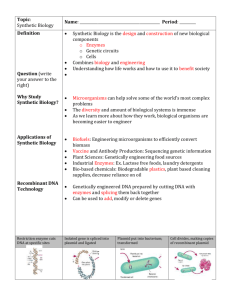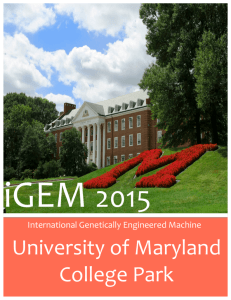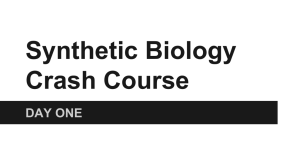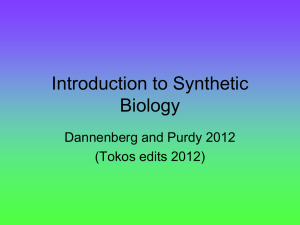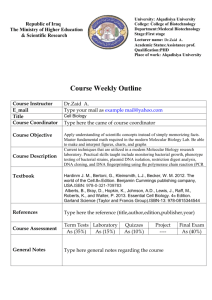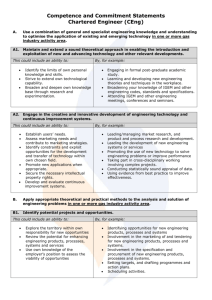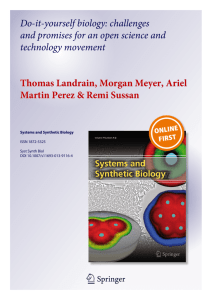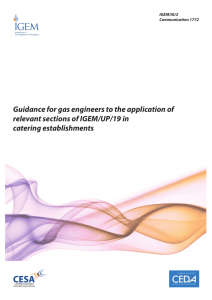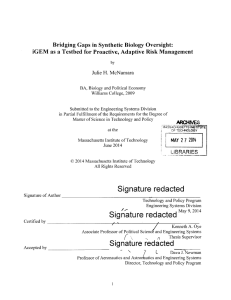iGEM 101 Syllabus Spring 2015
advertisement
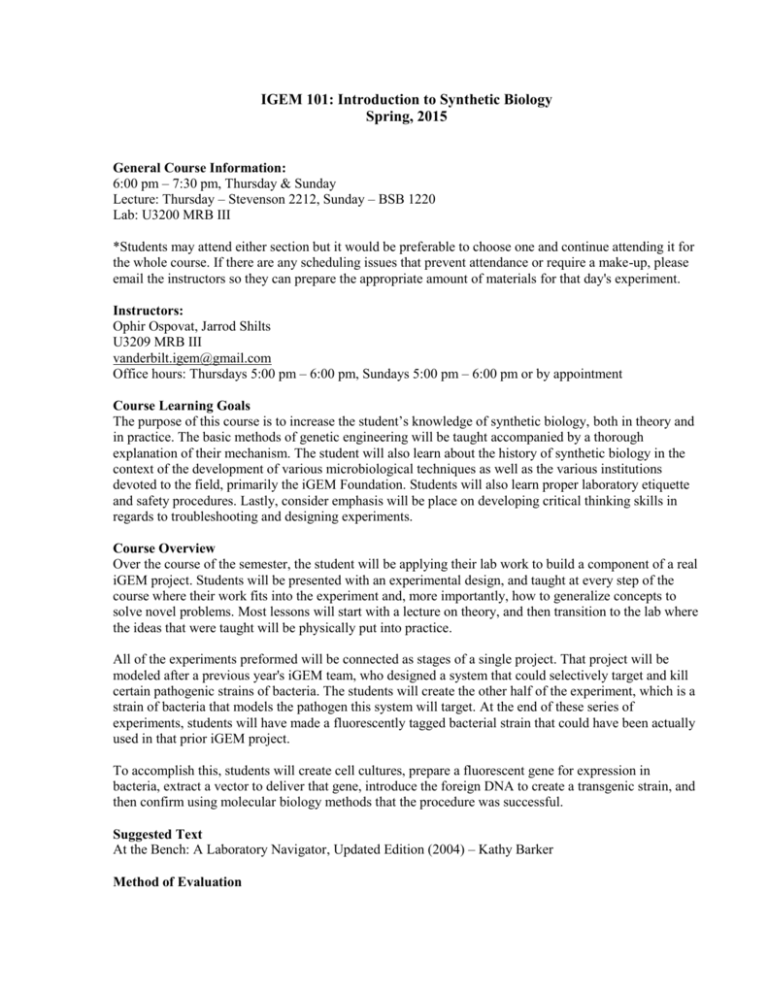
IGEM 101: Introduction to Synthetic Biology Spring, 2015 General Course Information: 6:00 pm – 7:30 pm, Thursday & Sunday Lecture: Thursday – Stevenson 2212, Sunday – BSB 1220 Lab: U3200 MRB III *Students may attend either section but it would be preferable to choose one and continue attending it for the whole course. If there are any scheduling issues that prevent attendance or require a make-up, please email the instructors so they can prepare the appropriate amount of materials for that day's experiment. Instructors: Ophir Ospovat, Jarrod Shilts U3209 MRB III vanderbilt.igem@gmail.com Office hours: Thursdays 5:00 pm – 6:00 pm, Sundays 5:00 pm – 6:00 pm or by appointment Course Learning Goals The purpose of this course is to increase the student’s knowledge of synthetic biology, both in theory and in practice. The basic methods of genetic engineering will be taught accompanied by a thorough explanation of their mechanism. The student will also learn about the history of synthetic biology in the context of the development of various microbiological techniques as well as the various institutions devoted to the field, primarily the iGEM Foundation. Students will also learn proper laboratory etiquette and safety procedures. Lastly, consider emphasis will be place on developing critical thinking skills in regards to troubleshooting and designing experiments. Course Overview Over the course of the semester, the student will be applying their lab work to build a component of a real iGEM project. Students will be presented with an experimental design, and taught at every step of the course where their work fits into the experiment and, more importantly, how to generalize concepts to solve novel problems. Most lessons will start with a lecture on theory, and then transition to the lab where the ideas that were taught will be physically put into practice. All of the experiments preformed will be connected as stages of a single project. That project will be modeled after a previous year's iGEM team, who designed a system that could selectively target and kill certain pathogenic strains of bacteria. The students will create the other half of the experiment, which is a strain of bacteria that models the pathogen this system will target. At the end of these series of experiments, students will have made a fluorescently tagged bacterial strain that could have been actually used in that prior iGEM project. To accomplish this, students will create cell cultures, prepare a fluorescent gene for expression in bacteria, extract a vector to deliver that gene, introduce the foreign DNA to create a transgenic strain, and then confirm using molecular biology methods that the procedure was successful. Suggested Text At the Bench: A Laboratory Navigator, Updated Edition (2004) – Kathy Barker Method of Evaluation Certification for completing the course will be awarded on a pass/fail basis. Percentage grades will also be given based on the point totals bellow, but will not appear on the final certificate. Experimental Proficiency (6 x 7 points each) Lab Notebook (6 x 3 points each) Final exam (40 points) Experimental proficiency will gauge general ability in handling the technique as well as possible instructor questions about what is happening, why it is happening, and what would happen under alternative conditions. Each experiment will also have a notebook write-up, modeled on a sample writeup, which will be due at the end of each experiment. Final exam will consist of short answer questions that gauge critical thinking ability and other essential concepts that are covered in the course. Course Schedule Session Session 1 Dates Feb-12-15 (R) Feb-15-15 (S) Title Introduction to Synthetic Biology, Liquid Culture & Sterile Technique Session 2 Feb-19-15 (R) Feb-22-15 (S) Plasmid Vectors, and Plasmid Extraction (Miniprep) Session 3 Feb-26-15 (R) Mar-8-15 (S) DNA Gel Electrophoresis and Restriction Endonucleases Session 4 Mar-12-15 (R) Mar-15-15 (S) DNA Purification Session 5 Mar-19-15 (R) Mar-22-15 (S) Ligation and Bacterial Transformation Session 6 Mar-26-15 (R) Mar-29-15 (S) Polymerase Chain Reaction (PCR) and Primer Design Description Introduction to the history and methods of synthetic biology. Experimental design. Project examples from the iGEM competition. Cell cultures and sterile technique. Recommended Reading: Chapters 1-5, 9 Gene delivery vectors. Plasmid features and production. Extracting plasmid (miniprep) Recommended Reading: Chapter 12, 14 Electrophoresis to separate and identify DNA. Interpreting results of a gel. Restriction endonuclease digestion of DNA into fragments. Recommended Reading: Chapter 15 Extracting specific pieces of DNA from an agarose gel. Purifying away contaminants from mixtures of DNA and protein. Recommended Reading: Chapter 7, 8 Ligating together cut fragments of DNA. Transformation of competent bacterial cells. Selection for cells of interest. Recommended Reading: Chapter 11 DNA replication in vivo and in vitro. Optimizing conditions for PCR. Designing primers for specific genes. Recommended Reading: Chapter 6 Session 7 Apr-2-15 (R) Apr-5-15 (S) Gene Sequencing Technologies and Model Organisms Session 8 Apr-9-15 (R) Apr-12-15 (S) Exam Methods and uses of DNA sequencing. Overview of different model systems commonly used in molecular biology and each of their strengths when planning an experiment Recommended Reading: Chapter 10 Cumulative examination of important concepts covered during the course.
